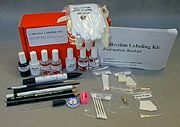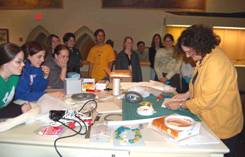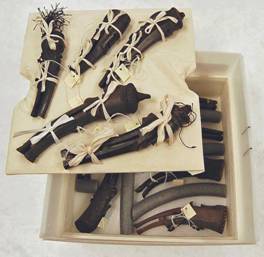Collection Labeling Kit 
Based on work by the AIC/AAM Joint Committee on Numbering, this kit provides three ½ ounce brush top bottles of different clear lacquers, two bottles of solvents, and bottles of black and white acrylic inks. Included are three different ink applicators: a fine brush, a quill pen and an empty COPIC marker. Three different pencils, two that are water soluble, samples of different tags and ties, and gloves also are included. A small booklet provides information on how to use each of the items in the kit.
This is a popular item. Please be patient with us if your order takes longer than expected. We manufacture to order.
|

In February and March we offer two more courses for the National Association of Tribal Historic Preservation Officers (NATHPO):
Students must be staff at a tribal institution and meet NATHPO qualifications. These courses are subsidized by the Institute of Museum and Library Services through a grant awarded to NATHPO.
To be considered for one or both of the courses, fill out the online application at: http://nathpo.org/NNMTP/onlineclassesApplication.html
|
Regional Workshops
Where you can find some of our instructors this year:
John Simmons
- February 12, 2014, The Academy of Natural Sciences of Drexel University (Philadelphia, PA), $60
Steve Layne
Certified Institutional Protection Specialist/Supervisor
- February 4, 2013, Bowdoin College
Certified Institutional Protection Manager
- February 5, 2013, Bowdoin College, Brunswick, Maine
- February 17, 2013, Smithsonian's National Conference on Cultural Property Protection, Washington, DC
- March 10, 2013, The Midwest Security Conference, Lisle, IL
- May 18, 2013, AAM Annual Meeting, Baltimore, MD
IFCPP Conference
- August 3-7, 2013, San Diego, CA
 | | Helen Alten demonstrating storage mounts at a workshop in Beloit, Wisconsin. |
Helen Alten
Disaster Preparedness Workshop
- June 14-15, 2013, Athens, Greece.
Collections Management and Practices
- July 11-12, 2013, Bryn Mawr College, Bryn Mawr, PA, $270 AASLH members/$345 nonmembers. $40 discount if fee received by June 5.
|
|
|
Welcome to the Collections Caretaker e-Newsletter from Northern States Conservation Center. The newsletter is designed to bring you timely and helpful content that is pertinent to situations we all encounter in our museum and archives work. Feel free to let us know what topics you would like to see featured in Collections Caretaker or even contribute an article.
|
|
Thinking Inside the Box
By Helen Alten
Housings should:
- Provide support and protection
- Enable study with minimal handling
- Be constructed using materials that have good aging characteristics and versatility
- Philadelphia Museum of Art (Rehousing the Costume and Textile Collection)
Walk into storage. Pick out any box. Open it up. What do you see?
In most museums, the inside of the box is the unseen, unnoticed, misunderstood cause of damage to the collections within.
But you know you have done the right thing, because you bought those incredibly expensive acid-free storage boxes and now the entire storage area is a lovely shade of gray. Or cream. Or blue.
The box isn't the end of the story for the object. How it is put into the box is as important as buying the correct box. One of the first rules of good storage is, "No object should bear the weight of another object." Stacking causes crushing, distortion, cracks, tears and splits.
Inside the box
Look inside the box again. What do you see? Are there 15 dresses folded and stacked on top of each other? Are there hundreds of Ziploc baggies holding little ephemera - pins, cards, ribbons - all stuffed in the box? Are there three or four different objects inside, perhaps rolled up in acid-free tissue paper?
If a box contains more than one object, then it needs trays, shelves, and separators or dividers inside the box. For small objects, there are commercially available trays that fit inside a document box. But for larger objects, such as a textile box, you might have to make the tray and its supports.
Do contents shift?
Tilt your box gently. Do the contents shift and move? Then you know they aren't well stored. An object stored well inside an acid-free box won't shift when the box is moved or tilted, because it is well supported and braced with the same care one would take to support the object if it was on exhibit.
Removing contents
Another storage precept is: "All objects should be well supported." This means well supported in storage, transit and exhibit. Think about how you remove the contents of the box. Do you reach in and pull things out? Are they well supported when you do that? If an object, especially a flexible object, is on a support tray or shelf, you can lift out the tray or shelf, and the object remains fully supported. You don't have to touch the object when removing it from the box. And that tray becomes a handling support, making it easier to move the item from one spot to another.
 | | A storage box from the Logan Museum shows how objects are stored on removable shelves. |
Materials for trays
Storage trays, shelves and supports can be made from acid-free foamcor, acid-free corrugated cardboard (usually a double ply with corrugations at right angles to each other), or rigid polyethylene foam.
The trays need to be padded. One method: cover the rigid support with needle-punched polyester quilt batting covered with washed muslin or other cotton fabric. Another method: cover the rigid support with one-quarter inch polyethylene foam covered with acid-free tissue paper.
Cotton twill tape ties hold objects on the trays.
Irregular shapes are padded with polyethylene foam support mounts or cotton stockinette pillows. Polyethylene rods, made to fill cracks in buildings and cement, are extremely useful to brace items on storage trays. These rods are known as backer rods or tri-rod.
Final principles
The final principle of good storage is that it increases the life-span of the object. This means it mitigates all 10 of the agents of deterioration. The acid-free box you purchased reduces contaminants, radiation (light) damage, and buffers relative humidity fluctuations. But it needs help to reduce other agents of deterioration. The box isn't enough. It needs shelves, supports, and ties. Good padding and bracing provide support that can go a long way to defeating the physical force damages caused by gravity, vibrations, and dropping.
Helen Alten is the Director of Northern States Conservation Center. She created our first online class in 2003, MS 201: Storage for Infinity. The course is now taught by Lori Benson. |
Laws Affecting Collectingby John E. Simmons
The late Stephen E. Weil (who was both a lawyer and museum director), probably said it best:
"Our laws are too complex, and the consequences of misunderstanding them too grave, to make it thinkable that the legal aspects of museum management should be based on anything less than the best available professional advice."
(From "Vincible Ignorance: Museums and the Law," pages 133-142 in Beauty and the Beasts, 1983)
Despite Weil's caution, my experience has been that most museums function with very little legal advice or guidance, which can lead to trouble.
Many of the laws and regulations that affect the way collections are managed are those that apply to most other public or non-profit institutions as well-for example, laws and regulations governing how employees are treated, or institutional liability for failing to address hazards. For the most part, we won't address these sorts of laws and regulations, but will focus on those particular to collections management in museums.
But first, a very important word of caution-if you ever think that you (or the institution you work for) needs legal advice, talk to a qualified lawyer with a specialty in the area you are concerned about. Dealing with legal problems is not a good time to try to "do it yourself".
LAWS AFFECTING COLLECTIONS MANAGEMENT
Americans with Disabilities Act, 1990
For our purposes, the Americans with Disability Act (ADA) of 1990 is most notable for the way it affects public access to the museum. Good information on general access for the disabled is readily available from several sources (a good resource is the Americans with Disability Act home page, http://www.ada.gov/). Our concern here is the issue of access for the disabled to museum collections.
LAWS AFFECTING COLLECTING AND COLLECTIONS IN THE US
In her book, Museum Law: A Guide for Officers, Directors, and Counsel (1994:307), Marilyn Phelan observes that "The United States has been somewhat dilatory in its efforts to preserve and to protect artistic, archaeological, and anthropological resources. As one court observed, the United States has had a 'short cultural memory.'"
Antiquities Act of 1906
The Antiquities Act of 1906 protects historic ruins on public lands from being destroyed or damaged. Under this act, anyone who appropriates an object of antiquity from public lands without permission of the Department of the Interior may be held liable and subjected to fine or imprisonment. This act was passed in response to vandalism at the Casa Grande ruins in Arizona and because of concerns about the protection of Mount Vernon in Virginia (the act also authorized the President to set aside historic places, landmarks, and structures as national monuments).
Historic Sites Act of 1935
This act strengthened the Antiquities Act of 1906 by declaring it a national policy "to preserve for public use historic sites, buildings, and objects of national significance for the inspiration and benefit of the people of the United States." There are numerous other pieces of legislation that protect historic sites (there is an excellent summation of these in the book by Phelan, Museum Law. A Guide for Officers, Directors, and Counsel).
Archaeological Resources Protection Act of 1979
This act expanded the Antiquities Act, and further protected archaeological resources and sites on public land and Indian land. The act prohibits the sale, purchase, transport, exchange, or receipt of any archaeological resources removed without permission from public or Indian lands.
Pre-Colombian Art Act of 1972
The Pre-Columbian Art Act of 1972 was adopted to prohibit the importation into the United States of any pre-Columbian material without a certificate of exportation from the country of origin.
INTERNATIONAL LAWS AND REGULATIONS AFFECTING COLLECTING AND COLLECTIONS
Hague Convention for the Protection of Cultural Property in the Event of Armed Conflict, 1954
This was the first significant international agreement to protect cultural property. The intent of the Hague Convention was to protect cultural property during wartime, which mostly meant protection against looting.
Convention on the Means of Prohibiting and Preventing the Illicit Import, Export and Transfer of Ownership of Cultural Property Convention (UNESCO), 1970 and the Cultural Property Implementation Act, 1983
Although it was ratified by the US Senate in 1972, it took until 1983 for the US Congress to implement the 1970 UNESCO Convention by enacting the Cultural Property Implementation Act. This act makes certain forms of cultural property subject to seizure if imported into the US in violation of the act, and allows the President to enter into bilateral agreements with other countries to prohibit the importation of certain cultural property. The UNESCO Convention is focused on peacetime destruction and looting of cultural property, particularly things obtained without permission from the country of origin and later sold and imported to other countries. The convention opposes "all illicit import, export, and transfer of ownership of cultural property." The UNESCO Convention defines "archaeological material" as objects of cultural significance that are at least 250 years old; an "object of ethnographical interest" is defined as the product of a tribal or non-industrial society that is important to the cultural heritage of a people because of its distinctive characteristics, rarity, or relevance to the history of the people.
UNIDROIT Convention on Stolen or Illegally Exported Cultural Objects (UNIDROIT 1995)
The Unidroit Convention was written to correct what were seen as a few loopholes in the 1970 UNESCO Convention by making it easier to identify the current location of stolen cultural property and make it easier to recover it. It went into effect in July 1998 after the first five countries ratified the accord. The Unidroit Convention provides a means for a government to recover stolen or illegally exported cultural property (illegal cultural property includes objects illegally excavated). Although the United States participated in writing the convention, the US government has not yet ratified it, but 32 other countries have.
A 2006 article in Museum News about international laws regulating cultural objects concluded with these words:
"The law of this country has steadily evolved in the direction of enforcing foreign claims regarding antiquities and other objects protected by cultural patrimony laws. It is unlikely to reverse course anytime soon. Given the legal environment, it is imperative that museum professionals, under the guidance of in-house or outside counsel, familiarize themselves with the cultural patrimony laws of art-rich source nations and also gain an appreciation for the ways federal investigators view the circumstances surrounding the importation or sale of antiquities. A healthy respect for the breadth of foreign law, coupled with an eye for spotting gaps in the provenance of antiquity under consideration for acquisition, can generally provide important protection against future legal claims." [Barr, Evan. 2006. From open-air bazaar to buyer beware: evolution of the antiquities trade. Museum News 85(6):48-53].
Excerpt from MS266: Legal Issues in Collections Management.
John E. Simmons runs Museologica, an independent consulting company, and serves as Adjunct Curator of Collections at the Earth and Mineral Sciences Museum and Art Gallery at Pennsylvania State University. He has a B.S. in Systematics and Ecology and a Master's degree in Historical Administration and Museum Studies. Simmons began his professional career as a zoo keeper, then worked as collections manager at the California Academy of Sciences and the Natural History Museum of the University of Kansas, where he also served as Director of the Museum Studies Program until 2007. In 2011, he received the Carolyn L. Rose Award for outstanding commitment to Natural History Collections Care and Management from the Society for the Preservation of Natural History Collections. He is a recipient of both the Superior Voluntary Service Award from the American Association of Museums and the Chancellor's Award for Outstanding Mentoring of Graduate Students from the University of Kansas. Simmons' publications include three books, Herpetological Collecting and Collections Management (2002), Cuidado, Manejo y Conservación de las Colecciones Biológicas (2005, with Yaneth Muñoz-Saba), and Things Great and Small: Collections Management Policies (2006). He consults, teaches, and does field work in the US, Latin America and Asia.
|
Northern States Conservation Center (NSCC) provides training, collection care, preservation and conservation treatment services. NSCC offers online museum studies classes at www.museumclasses.org in Collections Management & Care, Museum Administration & Management, Exhibit Practices and Museum Facilities Management.
Sincerely,
Helen Alten, DirectorBrad Bredehoft, Sales and Technology Manager
|
|
|
|
|
|
|



